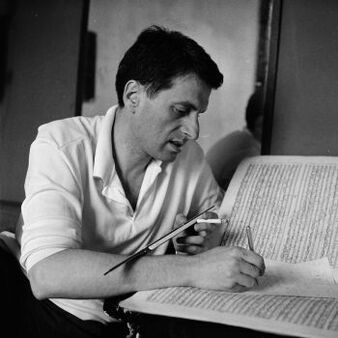Iannis Xenakis
 | |
| Born |
May 29, 1922 Brăila, Romania |
|---|---|
| Died |
February 4, 2001 (aged 78) Paris, France |
Iannis Xenakis (Ιάννης Ξενάκης, 1922–2001) was a Greek-French composer, music theorist, and architect-engineer.
Studied engineering in Athens; upon graduation, he joined the studio of Le Corbusier in Paris, and worked with him on architectural projects for 12 years, most importantly the Sainte Marie de La Tourette, on which the two architects collaborated, and the Philips Pavilion at Expo 58, which Xenakis designed alone. It was not until he was nearly 30 that he undertook serious musical studies; enrolled in the class of Messiaen, and also took lessons with Honegger and Milhaud. Bypassing Schoenbergian dodecaphony and Webernian serialism, he began writing music according to the mathematical theories of sets and calculus of probability. In 1962 Xenakis wrote two pieces for the IBM 7090 computer, Morsima-Amorsima (ST/4–2, 030762) [Stochastic Music for 4 Performers, No. 1] and ST/10–1, 080262 (FLAC, analysis); programmed the music specifying duration and density of "sound events", leaving the parameters of pitch, velocity, and dynamics to the computer; both pieces were performed at the Technological Institute of Athens on 16 December 1962, sponsored by Hatzidakis (see below) and conducted by Lukas Foss. Among his important works are Metastaseis (1953-54, score) for orchestra, which introduced independent parts for every musician of the orchestra; percussion works such as Psappha (1975) and Pléïades (1979); and compositions that introduced spatialization by dispersing musicians among the audience, such as Terretektorh (1966). In 1979, he perfected the Polyagogic Method (UPIC), through which computer graphic images converted into musical structures. In Polytopes, a work whose title refers to Euclidean geometry, music is combined with visual stimuli in space (video).
Recordings[edit]
- Sound works on UbuWeb
- 6 electronic music pieces (FLAC, torrent)
Writings, books, catalogues[edit]

- Musiques formelles. Noveaux principes formels de composition musicale, Paris: Richard Masse, 1963, 232 pp; repr., Paris: Stock, 1981, 261 pp. (French)
- Formalized Music: Thought and Mathematics in Composition, trans. Christopher Butchers, G. H. Hopkins and John Challifour, Indiana University Press, 1971, 273 pp; new ed., exp., ed. & trans. Sharon Kanach, Hillsdale, NY: Pendragon Press, 1992, 387 pp.
- Musique. Architecture, Tournai: Casterman, 1971, 176 pp; new ed., rev., Tournai: Casterman, 1976, 238 pp.
- trans. Yuji Takahashi, Tokyo, Zen-On Music Company CTD, 1976. (Japanese)
- Musica. Archittetura, Milan: Spirali, 1982. (Italian)
- trans. Anna Bofil, Barcelona: Antoni Bosch, 1982. (in Catalan)
- Arts/Sciences. Alliages, Tournai: Casterman, 1979, 152 pp, HTML. Transcription from the tape recordings of his thesis defense for a doctorat d'Etat at the Sorbonne in the spring of 1976. (French)
- Arts/Sciences, Alloys: The Thesis Defense of Iannis Xenakis before Olivier Messiaen, Michel Ragon, Olivier Revault d'Allonnes, Michel Serres, and Bernard Teyssedre, trans. Sharon Kanach, Stuyvesant, NY: Pendragon Press, 1985, HTML; 1992, 150 pp. [1] [2] Review: Polansky (1992).
- Quaderni della Civica Scuola di Musica di Milano 18: "Arti/Scienze: Lenghe", 1989. (Italian)
- Kéleütha: écrits, ed. Alain Galliari, intro. & notes Benoit Gibson, Paris: L'Arche, 1994, 143 pp. Collection of 15 articles published between 1955 and 1988. (French)
- Musique et originalit, Paris: Sguier, 1996, 58 pp. Collection of 4 articles. (French)
- Κειμενα περι μουσικής και αρχιτεκτονικής [Texts on Music and Architecture], ed. Makis Solomos, trans. Tina Plyta, Athens: Υθγιοη, 2001, 276 pp. (Greek)
- La Musique de l'architecture, ed. & comm. Sharon Kanach, Marseille: Parenthses, 2003. (French)
- Music and Architecture: Architectural Projects, Texts, and Realizations, ed., trans. & comm. Sharon Kanach, Hillsdale, NY: Pendragon Press, 2008, 337 pp.
- Iannis Xenakis: Architect, Composer, Visionary, The Drawing Center, 2010. Catalogue of his drawings. With essays by Ivan Hewett, Carey Lovelace, Sharon Kanach, and Mâkhi Xenakis.
- Bibliography
- Annotated bibliography at Iannis-Xenakis.org
- Iannis Xenakis Bibliography and Discography, compiled by James Harley.
Interviews, conversations[edit]
- Morton Feldman and Iannis Xenakis in Conversation [1986]. Took place on 4 July 1986 at De Kloveniersdoelen, Middelburg, The Netherlands, as part of a five day master-class given by Morton Feldman during the Festival Nieuwe Muziek, 19 June–6 July 1986.
- Bálint András Varga, Conversations with Iannis Xenakis, London: Faber and Faber, 1996, 255 pp. Conducted between 1980 and 1989.
Literature[edit]
- L'Arc, 51: Xenakis, Aix-en-Provence, 1972, 88 pp. (French)
- James Harley, Xenakis: His Life in Music, Routledge, 2004. (English)
- Dimitris Exarchos, Iannis Xenakis and Sieve Theory: An Analysis of the Late Music (1984-1993), London: Goldsmiths, 2007. Figures and Appendices. Dissertation. [3] (English)
- Ralph Paland, Christoph von Blumröder (eds.), Iannis Xenakis: Das elektroakustiche Werk, Vienna: Apfel, 2009. Review: Harley (2010). (German),(English)
- Fritz van der Waa, "Xenakis' Calculated Sound Chaos", 2011. (English)
- "Xenakis: Architektur+Musik", BaunetzWoche 237 (2011), pp 4-20. (German)
- Martin Flašar, Poème électronique, 1958: Le Corbusier, E. Varèse, I. Xenakis, Brno: Masaryk University, 2012, 162 pp. (Czech)
- Charles Turner, Xenakis in America, Tappan/NY: One Block Avenue, 2014, 146 pp. (English)
- Joris André Odiel De Henau, Towards an Aesthetics of the '(in)formel': Time, Space and the Dialectical Image in the Music of Varèse, Feldman and Xenakis, Durham University, 2015, 491 pp. PhD dissertation. (English)
- Alfia Nakipbekova (ed.), Exploring Xenakis: Performance, Practice, Philosophy, Vernon Press, 2019. [4]
- From Xenakis’s UPIC to Graphic Notation Today, eds. Peter Weibel, Ludger Brümmer, and Sharon Kanach, Berlin: Hatje Cantz, and Karlsruhe: ZKM, 2020, 672 pp.
- Bibliography
- Annotated bibliography, prepared by Makis Solomos.
